Physical Address
304 North Cardinal St.
Dorchester Center, MA 02124
Wilms tumor is also known as nephroblastoma (currently the preferred term). It constitutes the prototypical example of a neoplastic process that faithfully recapitulates embryogenesis at the morphologic and molecular levels. It is seen primarily in infants, 50% of the cases occurring before the age of 3 years and 90% before the age of 6 years. However, Wilms tumor is only exceptionally seen as a congenital neoplasm, a point of great importance in the differential diagnosis with mesoblastic nephroma. There are also well-documented cases of Wilms tumors in adolescents and adults, but this may represent a somewhat different disease with distinct genetic features and significantly worse clinical outcomes. There is no appreciable sex predilection. The risk in Caucasians is lower than in Asians, but higher than in patients of African descent.
The classic location for Wilms tumor is the kidney. Both kidneys are equally affected, the incidence of synchronous or metachronous bilateral involvement being 5%–10%. Cases with the typical morphologic features of Wilms tumor have rarely been recorded in extrarenal sites, including retroperitoneum, sacrococcygeal region, testis, uterus (sometimes presenting as a cervical polyp), inguinal canal, and mediastinum. Some of them have arisen within a teratoma, and even those in which this feature was not evident have been viewed by some authors as teratomas with a predominant or exclusive nephroblastic component.
Wilms tumor has been reported in monozygous twins and other familial settings. Conditions associated with the highest risk of Wilms tumor are Wilms–aniridia genital anomaly–retardation (WAGR) syndrome, omphalocele–macroglossia (Beckwith–Wiedemann syndrome), hemihypertrophy, Denys–Drash syndrome, and familial nephroblastoma. Other conditions associated with Wilms tumor are renal and genital malformations, cutaneous nevi and angiomas, trisomy 18, Klippel–Trénaunay syndrome, neurofibromatosis, Bloom syndrome, Frasier syndrome, Simpson-Golabi-Behmel syndrome, Perlman syndrome, and cerebral gigantism (Sotos syndrome). The incidence of congenital abnormalities of the urogenital tract is particularly high for Wilms tumors occurring during the first year of life and/or involving both kidneys. Wilms tumor has also been encountered in association with other malignancies, such as osteosarcoma, botryoid variant of embryonal rhabdomyosarcoma, retinoblastoma, hepatocellular carcinoma, and neuroblastoma.
The classic clinical presentation of Wilms tumor is in the form of an abdominal mass felt by the mother when handling the child. Hematuria and pain are rare. Hypertension, present in a minority of the cases, has been shown to be caused by renin secretion by the tumor. Proteinuria may be the result of tumor-associated glomerular disease in the non-neoplastic kidney. Sometimes the first symptoms are related to traumatic rupture. Cases have been reported presenting as sudden death resulting from tumor embolism.
Imaging studies show a solid intrarenal mass that often displaces and distorts the collecting system. Foci of calcification may be identified.
Grossly, most Wilms tumors are solitary, well circumscribed, rounded, and of soft consistency. Their size is extremely variable, and their median weight is 550 g. The cut section is predominantly solid and pale gray or tan and often exhibits areas of cystic change, necrosis, and hemorrhage ( Fig. 24.1 ). A lobular pattern resulting from fibrous septation is common. Multicentric tumor foci are found in 7% of the cases.
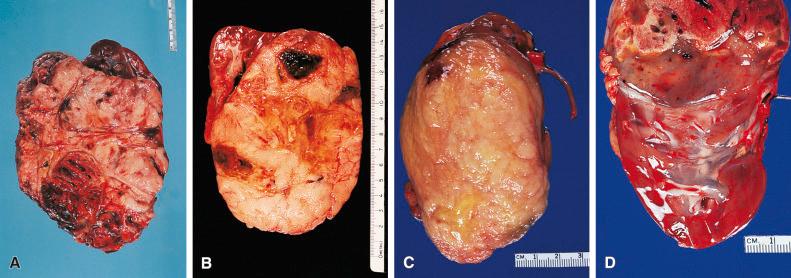
Microscopically, three major components are identified: undifferentiated blastema, mesenchymal (stromal) tissue, and epithelial tissue. Most Wilms tumors show a representation of all three components, but the proportions vary widely from case to case and sometimes from region to region in the same tumor. Some tumors are biphasic, and still others are monophasic (monomorphous). The blastomatous areas are extremely cellular and composed of small round-to-oval primitive cells; the cytoplasm is usually very scant, but sometimes is more abundant and exhibits an oncocytoid appearance. Adjacent nuclei commonly appear to overlap. The pattern of growth may be diffuse, nodular, cordlike (serpentine), or basaloid (with peripheral palisading). Particularly on biopsy, Wilms tumors in which the blastomatous component predominates can be confused with any of the small round cell tumors (including neuroblastoma), rhabdoid tumor, or clear cell sarcoma of kidney. The mesenchymal elements usually have spindle cells with fibroblastic or smooth muscle features, but may also exhibit differentiation toward various heterologous cell types, particularly skeletal muscle.
The epithelial component is characterized by the formation of embryonic tubular (and sometimes glomerular) structures that closely recapitulate the appearance of normal developing metanephric tubules (and glomeruli) at the light microscopic, ultrastructural, and lectin histochemistry levels ( Fig. 24.2 ). The differentiation can be so pronounced that tumor analogues of nearly all segments of the normal nephron can be formed. These tubular structures can be small and round, thus simulating the rosettes of neuroblastoma. Features favoring tubules over rosettes are presence of a lumen, single cell layer, distinct basal lamina, and surrounding fibromyxoid stroma. The differential diagnosis of predominantly epithelial Wilms tumors also includes cystic nephroma, renal cell carcinoma (RCC), and metanephric adenoma. Exceptionally, marked hydropic changes are seen in the tubular epithelial component. Heterologous epithelium may include ciliated, mucinous, squamous, or transitional epithelium ( Fig. 24.3 ).
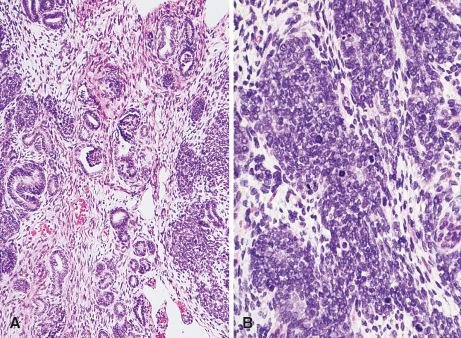
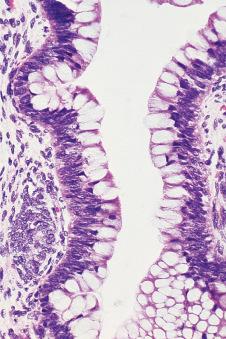
In the type known as papillonodular , grossly evident projections are seen extending from the septa into the cyst lumina, resulting in a fibroadenoma-like appearance on low-power microscopic examination.
Other heterologous tissues described in Wilms tumor are endocrine cells of various types ; renin-producing cells ; neuroepithelium, neuroblasts, and mature ganglion cells ; neuroglia ; adipose tissue; and cartilage, bone, and hematopoietic cells. Sometimes the variety of tissues present is such that the distinction between Wilms tumor and teratoma becomes blurred ; the term teratoid Wilms tumor has been used to describe these cases.
The distinct cystic partially differentiated Wilms tumor is discussed separately later.
Anaplastic features may be present focally or extensively in Wilms tumors (approximately 5%–8% of cases); they are discussed fully in the section on prognosis.
The immunohistochemical profile of the various components of Wilms tumor mirrors that of their counterparts in the developing kidney.
The epithelial elements react for keratin and epithelial membrane antigen (EMA) ; the mesenchymal elements show a reactivity pattern consonant with their morphologic appearance (such as positivity for myogenin and desmin in the rhabdomyomatous foci) ; and the neural elements—when present—exhibit reactivity for neuron-specific enolase, glial fibrillary acidic protein, and S-100 protein. Additional immunoreactivities of Wilms tumor include nuclear WT1 (80%, typically in epithelial and blastemal components), nuclear PAX8, CD56 (96%), and (unexpectedly) TTF-1; the latter, which is found in 17% of cases, represents a potential source of misdiagnosis.
The genetic loci predisposing to Wilms tumor are WT1 and WT2. The former is located in 11p13 and encodes a zinc finger transcription factor that is expressed in the early development of the urogenital system, with its germline point mutation and deletion being the underlying genetic alteration in Denys–Drash syndrome and WAGR syndrome, respectively. WT2 is located in 11p15.5, which contains the gene for insulin growth factor II, and is implicated in tumors associated with Beckwith–Wiedemann syndrome. Alterations of these genes may also be identified in sporadic tumors. A relationship has been shown between the level of expression of these genes and the microscopic features of the tumor.
Inactivation of the WTX gene located on the X chromosome is found in 6%–30% of cases of sporadic Wilms tumor. This results from somatic deletion or, less commonly, inactivating mutation of the gene on the single X chromosome in tumors of males or the active X chromosome in tumors of females. The pathogenetic role of WTX alteration in Wilms tumor is not fully elucidated, but downregulation of WTX leads to increased signaling in the Wnt pathway.
Activating mutation of the β-catenin gene CTNNB1 is found in 14%–20% of Wilms tumors, resulting in disturbance of the Wnt signaling pathway. It may be found in tumors with WT1 mutation, but not with WT1 wild-type.
Abnormalities in other chromosomes—1, 7q, 8, 12, and 16—have also been encountered. These genetic changes are identical in the various histologic components of the tumor, and 1p and 16q loss of heterozygosity (LOH) are discussed further under prognosis. Mutations of TP53 and/or overexpression of the protein are found in only 5% of the cases of Wilms tumor. They are largely restricted to the anaplastic foci and carry an unfavorable prognostic connotation. Similarly, MYCN amplification is seen in rare cases with aggressive behavior, most commonly with diffuse anaplasia. More recently, mutations in the SIX/2 pathway and the DROSHA/DGCR8 miRNA microprocessor complex have been described in high-risk blastemal Wilms tumors.
In advanced cases, local spread occurs in the perirenal soft tissues. From here, the tumor may directly involve the adrenal glands, bowel, liver, vertebrae, and paraspinal region; the latter may result in spinal cord compression. Invasion of the renal vein is common, but extension into the renal pelvis or ureter is a rare and late event. Metastases in regional lymph nodes are found in 15% of the cases. The most common sites of distant metastases are lungs, liver, and peritoneum. The presence of lung metastases in a child with a retroperitoneal neoplasm strongly favors a diagnosis of Wilms tumor over that of neuroblastoma. Conversely, the presence of bone metastases suggests a diagnosis other than Wilms tumor, since they occur in only 1% of the cases.
The therapy for Wilms tumor has been relatively standardized and is based largely on protocols from either the International Society of Paediatric Oncology (SIOP) or the Children's Oncology Group (COG). The specifics of these protocols are being continuously updated. The main differences between the two approaches are based on the use of presurgical therapy. The SIOP typically espouses preoperative chemotherapy followed by surgical resection. In this model, some regions require biopsies to confirm diagnosis prior to chemotherapy, while others do not. Further therapy is based on the initial response as measured by a post-therapy classification. Advocates of the SIOP approach cite fewer intraoperative tumor ruptures (due to therapy-related tumor shrinkage) and less upstaging. The COG typically advocates for initial surgical resection with subsequent therapy determined by tumor histology and stage. Its advocates cite prognostic stratification that allows for more tailored therapy. Despite these differences, the clinical outcomes for both the SIOP and COG approaches are very similar.
The overall cure rate for unilateral Wilms tumor is 80%–90%. A small percentage of long-term survivors of Wilms tumor develop a second malignant neoplasm, either because of a genetic predisposition to neoplasia or secondary to therapy.
The prognostic connotations of various clinical and morphologic parameters are as follows:
Age . Patients under 2 years of age have significantly fewer metastases and a better 5-year survival rate than those over 2 years.
Stage . Clinicopathologic staging of Wilms tumor is the most important prognostic determinant, based on either the SIOP or the COG systems ( Table 24.1 ). Capsular invasion, rupture at surgery, extrarenal vein invasion, tumor implants, lymph node metastases, distant metastases, and bilaterality are the main criteria used. Unfortunately, staging of Wilms tumor by the pathologist is fraught with pitfalls. The tumor “capsule” (or pseudocapsule) can be confused with the renal capsule; the renal sinus and surgical margins may be difficult to evaluate; and the renal vein may retract considerably, giving a false impression—when invaded—that tumor is present at the margin. It is important for sections to be taken from the renal sinus, the junction between tumor and normal kidney, the tumor capsule, and the uninvolved renal parenchyma. In a study of stage I cases, the following four features were found to be associated with increased rate of relapse: presence of an inflammatory pseudocapsule, invasion of the renal sinus, extensive infiltration of the renal capsule, and tumor infiltration of intrarenal vessels.
| STAGE | DESCRIPTION |
|---|---|
| Stage I | Completely resected tumor limited to the kidney. No intraoperative rupture or biopsy of the tumor prior to removal. No involvement of the vessels of the renal sinus. No evidence of tumor beyond the margins of resection. Regional lymph nodes confirmed negative microscopically. |
| Stage II | Completely resected tumor with no evidence of tumor at or beyond margins of resection. Tumor extends beyond the kidney as evidenced by regional extension of the tumor (through renal capsule, extensive invasion of the soft tissue of the renal sinus) or tumor in blood vessels within the nephrectomy specimen, but outside renal parenchyma. This includes blood vessels of the renal sinus. |
| Stage III | Residual tumor present after surgery, confined to abdomen. This includes the following:
|
| Stage IV | Hematogenous metastases or lymph node metastases outside the abdominopelvic region |
| Stage V | Bilateral renal involvement present at diagnosis. Each kidney should be substaged separately by above criteria. |
Size . Tumor mass, as measured by the weight of the excised specimen, is an important determinant of outcome, especially in stage I tumors.
Anaplasia . For a case of Wilms tumor to be placed into the anaplastic category, it should meet the following three criteria: (1) marked enlargement of nuclei within the blastemal, epithelial, or stromal cell lines (excepting skeletal muscle cells) to at least three times the diameter of adjacent nuclei of the same cell type; (2) obvious hyperchromasia of the enlarged nuclei; and (3) multipolar mitotic figures ( Fig. 24.4 ).
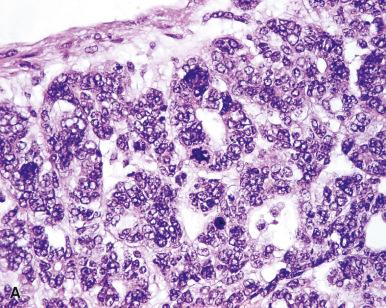
Anaplasia thus defined is present in about 4% of the cases, the incidence being higher in patients of African descent and in older patients. It is very uncommon in tumors from patients under 2 years of age; this is probably the reason for the better prognosis exhibited by this age group. Sometimes it is found in the metastases and not in the primary tumor.
Currently, focal anaplasia applies only to cases in which the previously defined changes are restricted to one or a few discrete loci within the primary tumor , with no anaplasia or marked nuclear atypia elsewhere . Specifically, focal anaplasia cannot be present in tumor infiltrating outside the kidney (e.g. renal sinus) or in intravascular tumor. Thorough tumor sampling (one section for each centimeter of tumor diameter) and careful mapping of where sections were taken is obviously needed to evaluate this feature properly. Cases with localized anaplasia in which the background tumor shows a degree of “marked” atypia (i.e. bordering on anaplasia, but falling short of the minimal threshold, typically due to nuclear pleomorphism without other features) have been referred to as showing “nuclear unrest” and are classified as diffuse anaplasia. Wilms tumors with anaplasia are referred to as having “unfavorable histology” in the sense of exhibiting a lesser response to chemotherapy. This predictive connotation is greater when the anaplasia is diffuse rather than focal, and since anaplasia predicts response to therapy, its significance in stage I tumors is debated.
Extensive tubular differentiation . This is said to be a good prognostic sign. According to some authors, this is also true for cases with extensive glomerular differentiation. This finding does not currently direct initial therapy.
Skeletal muscle differentiation . This feature does not seem to have a significant effect on prognosis, except when present in massive amounts. In the latter instance it is said to be associated with a better prognosis. This finding does not currently direct initial therapy.
Post-chemotherapy morphology . The SIOP classification is based largely on response to chemotherapy with three simple categories: completely necrotic (low risk), blastemal predominant (high risk), and “others” (intermediate risk). The incidence of anaplasia does not seem to be affected by this treatment modality (i.e. there is no evidence that therapy induces cytologic changes mimicking anaplasia).
TP53 mutation . Mutations of the TP53 gene, evaluated indirectly through the immunohistochemical detection of P53 protein overexpression, correlate with the presence of anaplasia at the histologic level and therefore with an unfavorable outcome.
LOH at 1p and 16q. Some studies have suggested that LOH at 1p and 16 q is an adverse prognostic factor in favorable histology Wilms tumors. Future COG and/or SIOP trials will likely attempt to further validate this finding.
Many of these prognostic parameters are used in the revised SIOP working classification for nephroblastoma ( Table 24.2 ).
| Stage I | Viable tumor limited to the kidney, or surrounded by an intact fibrous pseudocapsule and completely resected. No renal sinus invasion of soft tissue or vessels. Necrotic tumor or chemotherapy induced changes may be present in renal sinus or soft tissue outside of kidney without upstaging, as long as these changes do not extend to resection margins. Prior percutaneous core needle (Tru-cut) biopsy or fine-needle aspiration does not upstage the tumor. Tumor may infiltrate adrenal gland if adrenal capsule is intact. Tumor may be adherent to liver capsule but may not infiltrate liver parenchyma. |
| Stage II | Completely resected viable tumor extends beyond kidney or penetrates through the renal capsule or fibrous tumor pseudocapsule into perirenal fat. Tumor may infiltrate the renal sinus and/or invade blood vessels, but resection margins are clear. Tumor may infiltrate adjacent organs or vena cava, if completely resected with clear margins. |
| Stage III | Incomplete excision. Gross residual tumor remains in the patient, or tumor extends to resection margins on microscopic exam, including necrotic tumor or chemotherapy induced changes at resection margin.
|
| Stage IV | Hematogenous metastases or spread of tumor beyond the abdomen and pelvis. |
| Stage V | Bilateral renal tumors. Each side should be substaged by above criteria. |
Cystic partially differentiated Wilms tumor typically occurs in very young children, most less than 24 months old. By definition, this tumor should have an exclusively cystic gross appearance with thin septa and no solid nodules. It is typically large (mean of 10 cm), but well circumscribed. Histologically, the thin septa contain an admixture of different tissues, including fibrous tissue, skeletal muscle, fat, cartilage, blastema, and nephroblastomatous epithelium. Cysts may show papillary infolding, but no microscopic nodular masses should protrude from the cyst wall, as their presence suggests a cystic Wilms tumor. Hemorrhage, necrosis, and calcification are not features of cystic partially differentiated Wilms tumor. Surgical resection is typically curative and adjuvant therapy is not recommended for this clinically benign neoplasm. The main differential diagnosis is pediatric cystic nephroma, which (by definition) does not contain nephroblastomatous elements.
Nephroblastomatosis and nephrogenic rests are defined as persistent foci of embryonal cells (after 36 weeks gestation), but they are discussed here because of their frequent confusion and histogenetic relationship with Wilms tumor. Nephrogenic rests are seen in up to 40% of patients with Wilms tumor and approximately 1% of neonates. The term nephroblastomatosis refers to diffuse or multifocal nephrogenic rests. In its most florid form, the process is often associated with a variety of congenital anomalies and with hypertension.
Nephrogenic rests have been divided into perilobar and intralobar forms ( Fig. 24.5 ). The former, which is more common, is located peripherally, has sharply demarcated margins, is composed predominantly of blastema and tubules with scanty (or sclerotic) stroma, and is often multifocal. The intralobar form is randomly distributed in the cortex and medulla and has irregular margins. It shows a predominance of stroma over blastema and tubules and is usually solitary. Further methods of nephrogenic rest subclassification have also been proposed.
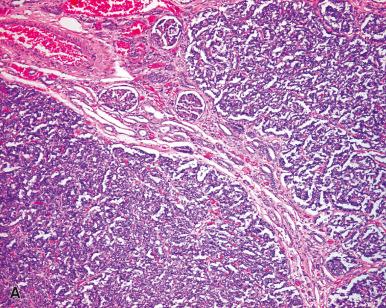
Nephroblastomatosis can be diagnosed by computed tomography (CT) scan, magnetic resonance imaging (MRI), or ultrasound. Grossly, the most exuberant examples of this disease can be distinguished from Wilms tumor because of the diffuse or multifocal nature of the process and the involvement of the entire subcapsular region. Microscopically, the mass is typically unencapsulated and composed of tightly packed nephrogenic epithelial cells that have a primitive but not anaplastic appearance. Stromal tissue is scanty; cartilage, striated cells, and primitive mesenchyme are absent. However, hyperplastic rests may have some foci that are cytologically indistinguishable from Wilms tumor, but have the distribution of a rest and no capsule. Other histologic mimics of nephrogenic rests include dysplastic medullary ray nodules (most commonly in Beckwith–Wiedemann syndrome) and embryonal hyperplasia (often in multicystic dysplasia and end-stage kidneys).
In cases associated with Wilms tumor, they have been found to share similar mutations. Perilobar rests often have 11p15 alterations and are commonly associated with hemihypertrophy and/or Beckwith–Wiedemann syndrome, while intralobar rests commonly have WT1 mutations and may be associated with Denys–Drash syndrome. CTNNB1 mutations are seen in intralobar rests, even in the absence of WT1 mutation.
A conservative therapeutic approach is indicated in cases of nephrogenic rests and nephroblastomatosis ; however, nephrogenic rests in patients less than 1 year of age (particularly if perilobar) and especially diffuse hyperplastic nephroblastomatosis are associated with the highest risk of contralateral Wilms tumor.
Congenital mesoblastic nephroma represents the most common renal tumor of newborns and is usually discovered before 6 months of age. Extraordinary examples in adults have been reported, but the diagnosis is rare after 2 years of age and should be carefully scrutinized outside that setting. Grossly, the tumor is solid, yellow-gray to tan, with a whorled configuration reminiscent of uterine leiomyoma ( Fig. 24.6 ). Most are centered near the hilus of the kidney. The tumor often appears well circumscribed, but it may infiltrate the renal parenchyma and even the perirenal fat microscopically. Areas of hemorrhage and necrosis are usually absent. A cystic variant of this tumor has been described.
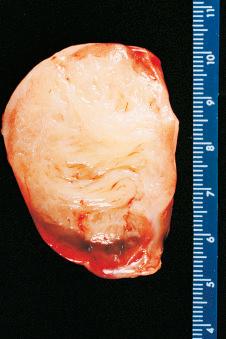
Microscopically, two distinct patterns are seen. “Classic” congenital mesoblastic nephroma resembles “infantile fibromatosis” of the renal sinus with long sweeping and intersecting fascicles composed of cytologically bland, elongated spindle cells ( Fig. 24.7 ). There is typically fine intracellular collagen imparting a light eosinophilic appearance. Tubules and glomeruli (sometimes exhibiting hyperplastic or metaplastic changes) may be entrapped by the spindle tumor cells. Small islands of hyaline cartilage and foci of extramedullary hematopoiesis may be present. There is no capsule separating the tumor from the uninvolved renal parenchyma.
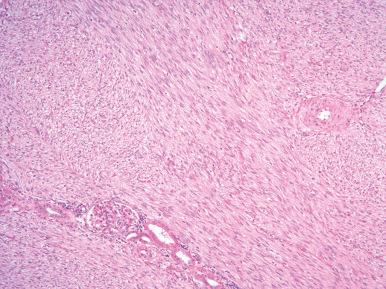
Cellular congenital mesoblastic nephroma is comprised of more densely cellular plump spindle cells with larger nuclei, resembling infantile fibrosarcoma ( Fig. 24.8 ). They are mitotically active, have a tendency to infiltrate the renal pelvis or perirenal tissue, and may contain areas of hemorrhage and necrosis. When classic and cellular patterns coexist, the tumors are designated as mixed.
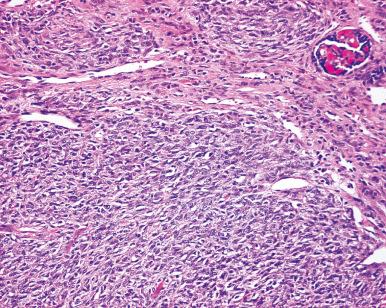
Immunohistochemically, the neoplastic cells often show expression of smooth muscle actin, while desmin staining is rare. CD34 is typically negative.
Congenital mesoblastic nephromas lack the abnormalities in chromosome 11 that characterize Wilms tumor and are associated instead with polysomies for chromosomes 8, 11, 17, and 20. Cellular congenital mesoblastic nephroma contains the t(12;15)(p13;q25) translocation, which results in the ETV6–NTRK3 gene fusion, the latter being detectable in paraffin-embedded material. This gene fusion is not found in classic mesoblastic nephroma. It appears that the occurrence of gene fusion antedates acquisition of chromosomal polysomies. The sharing of the same genetic abnormality between cellular congenital mesoblastic nephroma and infantile fibrosarcoma supports the notion that these two tumors represent a single neoplastic entity. Most mixed congenital mesoblastic nephromas lack the ETV6 fusion.
The large majority of congenital mesoblastic nephromas are cured following nephrectomy. Therefore, radiation therapy or chemotherapy is not indicated. In up to 7% of the cases, recurrence with local invasion of retroperitoneum will occur and may prove fatal. Cases associated with distant metastases to lung and brain have rarely been reported ; most of these aggressive tumors have had atypical morphologic features. Beckwith and Weeks have pointed out that in all but one of the recurrent congenital mesoblastic nephromas the patients were over 3 months of age at the time of the original nephrectomy; they believe that age at diagnosis and adequacy of excision may be more important prognostic factors than the morphologic features of the tumor. In a recent series, stage III cellular congenital mesoblastic nephromas in patients aged 3 months or older were particularly prone to develop local recurrences.
Clear cell sarcoma, formerly known as bone-metastasizing renal tumor and not to be confused with clear cell sarcoma of soft tissue, is a distinctive renal malignancy. It comprises approximately 4% of childhood renal tumors; its incidence peaks during the second year of life. Isolated cases have been described in adults and in association with familial colonic polyposis. Grossly, the tumor tends to be large, sharply outlined, and centered in the medullary or mid region of the kidney. They have a homogeneous cut surface of light brown-to-gray color and myxoid appearance ( Fig. 24.9 ). The consistency is usually hard, and cystic formations are common.
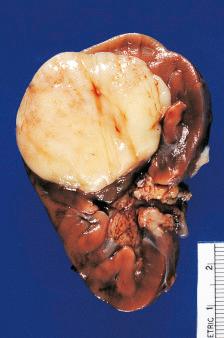
Microscopically, the most common pattern is that of a diffuse growth of relatively small cells with round normochromatic nuclei, inconspicuous nucleoli, light-staining (sometimes vacuolated) cytoplasm, and indistinct cell margins ( Fig. 24.10 ); however, the morphology is very heterogeneous. Despite the tumor name, clear cytoplasm is a prominent feature in only 20% of the cases. Nuclear grooves are common, and mitoses are infrequent. The fibrovascular stroma may result in arrangements of the tumor cells in nests, palisades, cords, or trabeculae ( Fig. 24.11 ). The latter should not be confused with the tubules or the serpentine arrangement of Wilms tumor. Myxoid changes, fibrosis, and hyalinization may be present, the appearance of the hyalinized tissue sometimes simulating osteoid ( Fig. 24.12 ). Cysts may result from dilation of entrapped tubules or from stromal degeneration. It has been remarked that the distinctive alveolar and arborizing vascular stroma is a more reliable diagnostic feature than the clear cells or the sclerosis. As many as nine histologic patterns of this tumor have been described, that is, classic, myxoid, sclerosing, cellular, epithelioid, palisading, spindle, storiform, and anaplastic.
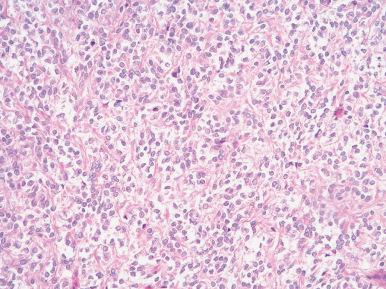
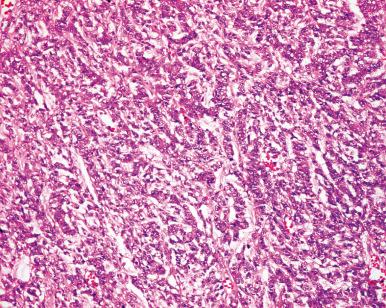
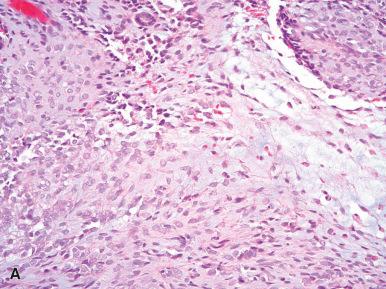
Clear cell sarcoma of kidney has recently been shown to harbor two main, and mutually exclusive, genetic events: somatic internal tandem duplication within the BCOR gene sequence (approximately 85%) and YWHAE-NUTM2 fusion (approximately 10%). A small subset of cases harbor neither event. These genetic features, as well as typical patient age and histology, are shared by a subset of extrarenal undifferentiated round cell sarcomas of infancy, suggesting a close relationship that was first noted histologically and ultrastructurally in 1991. Immunohistochemistry has historically not been helpful in confirming the diagnosis of clear cell sarcoma of kidney, but they are usually PAX8 negative. A new commercially available BCOR antibody has high sensitivity and specificity for clear cell sarcoma of kidney (and the other tumors harboring these same genetic events). One caveat is that a rare subset of synovial sarcomas may show BCOR overexpression.
Untreated clear cell sarcoma is a very malignant tumor, with a high tendency for relapse and a propensity for skeletal metastases, particularly skull. In this regard, it should be noted that skeletal metastases are extraordinarily rare in conventional Wilms tumors. Metastases of clear cell sarcoma also occur to regional lymph nodes, brain, lung, and liver. In contrast to Wilms tumor, these metastases tend to develop after long intervals following the removal of the primary tumor (5 years or more).
The overall survival rate in a series of 351 cases entered in a National Wilms Tumor Study (NWTS) trial was 69%. Multivariate analysis showed that treatment with doxorubicin, stage, age at diagnosis, and tumor necrosis were independent prognostic factors. Of note, stage I patients had a 98% survival rate.
Rhabdoid tumor of kidney is a distinct aggressive malignancy that is part of a larger family of SMACRB1-associated neoplasms. Most cases occur in young infants, the median age at diagnosis being 18 months; 80% occur before 2 years of age. Some of the cases have resulted in hypercalcemia.
Grossly, rhabdoid tumor is solid, soft, and relatively well circumscribed. Microscopically, it is a monomorphic neoplasm that always involves the medullary region and has a generally diffuse but sometimes alveolar or trabecular pattern of growth. The tumor cells are medium sized and generally round or oval with vesicular nuclei and prominent nucleoli and indistinct cell borders ( Fig. 24.13 ). However, they can also be spindled, prompting the possibility of confusion with mesoblastic nephroma or clear cell sarcoma. The most characteristic feature is the presence of a large cytoplasmic eosinophilic hyaline globule that displaces the nucleus laterally to result in a plasmacytoid or rhabdomyosarcomatous appearance ( Fig. 24.14 ). Ultrastructurally, this globule is made up of a tangle of intermediate filaments. Immunohistochemically, there is strong reactivity for vimentin and usually also for keratin, but generally not muscle (i.e. myogenin) or neural markers. It should be remarked that focal rhabdoid features resulting from accumulation of cytoplasmic filaments can be seen in many other renal tumors, including Wilms tumor, mesoblastic nephroma, and RCC. Loss of immunohistochemical expression of SMARCB1 (INI1/hSNF5/BAF47) is a feature of great help in the differential diagnosis with other pediatric small cell tumors. This results from biallelic alteration (deletion or mutation) of the hSNF5/INI1 locus at chromosome 22q11.2. Rare tumors retain SMARCB1 expression due to an alternative mutation in SMARCA4/BRG1. In about 15% of the cases, renal rhabdoid tumor is associated with primary atypical teratoid/rhabdoid tumors in the posterior fossa, and those patients typically harbor germline mutations in SMARCB1.
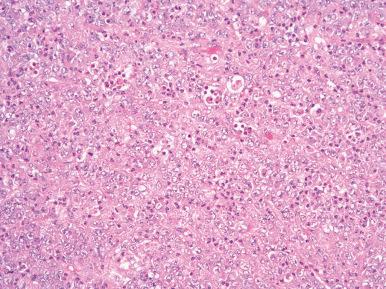
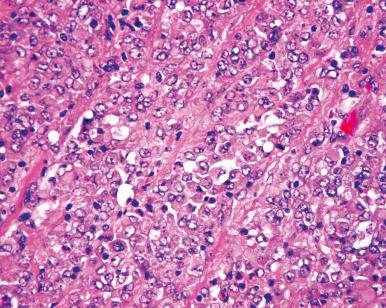
The behavior is extremely aggressive, even when occurring in young infants. The death rate is over 75%. High tumor stage and male sex are unfavorable prognostic signs.
Tumors morphologically, immunophenotypically, and genetically indistinguishable from rhabdoid tumor of kidney have been reported in many other anatomic sites.
Rhabdoid tumor of infantile kidney should not be equated to RCC with rhabdoid features (see later). Medullary carcinoma of the kidney may have significant histologic overlap with rhabdoid tumor, including loss of SMARCB1/INI-1 nuclear expression; however, patients with medullary carcinoma present at an older age and often have sickle cell trait. Many reported examples of rhabdoid tumor in patients over 5 years of age likely represent renal medullary carcinoma.
Pediatric cystic nephroma (multilocular cystic nephroma, multilocular cyst) is an uncommon but distinctive lesion that arises in early infancy. While this diagnostic term has previously been applied to tumors in all age groups, the World Health Organization (WHO) recommends that the term be restricted to infants, given that those tumors are genetically distinct and may be associated with a tumor predisposition syndrome (i.e. germline mutation in DICER1). Clinical manifestations result from the presence of a mass or, not uncommonly, from ureteral obstruction by one of the daughter locules.
Grossly, the lesion is usually solitary, unilateral, and sharply delineated from the uninvolved renal parenchyma. The usual size range is between 5 and 15 cm, and the outer surface is coarsely nodular. The cut surface shows a multilocular appearance, the individual cysts measuring from 1 mm to 3 cm or more ( Fig. 24.15 ). The wall of these cysts is thin and sometimes translucent and lacks papillary projections. The fluid within the cavity is usually serous. The cysts do not communicate with each other or with the pelvis. The remaining renal parenchyma is normal. Extension of the lesion beyond the renal capsule may occur.
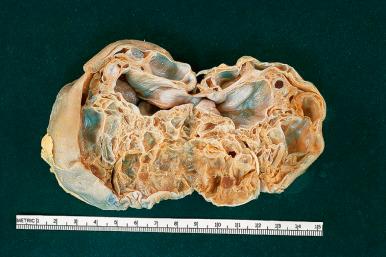
Microscopically, there are cysts of varying caliber separated by a spindled stroma ( Fig. 24.16 ). The cysts are lined by epithelium that ranges in height from columnar to extremely flat, resembling endothelium and simulating the appearance of lymphangioma. A “hobnail” pattern is common ( Fig. 24.17 ). The stroma between the cysts usually has a fibroblastic, nondescript nature (sometimes immunoreactive for hormone receptors), with variable stromal condensation adjacent to the cyst lining ( Fig. 24.18 ). Small well-differentiated tubules may be seen, but the presence of nephroblastomatous elements would preclude the diagnosis of cystic nephroma. As noted, many pediatric cystic nephromas have underlying DICER1 mutations, explaining their reported association with pleuropulmonary blastoma.
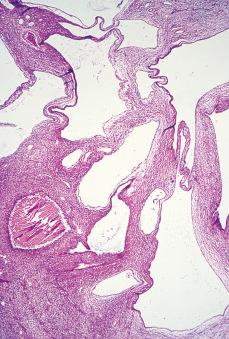
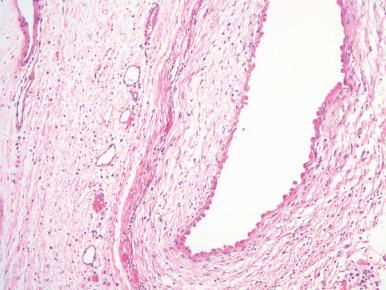

Rarely, intrarenal spindle cell sarcomas are identified in pediatric patients and have been described under various names, including embryonal sarcoma and anaplastic sarcoma. The location may be parenchymal or pelvicalyceal. Microscopically, the common denominator is a spindle cell component containing (either in a diffuse fashion or as multiple foci) varying levels of pleomorphism with some examples showing bizarre pleomorphic cells and atypical mitotic figures. Chondromatous and osteoid foci are sometimes present. Immunohistochemically, a haphazard pattern of reactivity is recorded; however, keratin stains are negative. An associated cystic component, sometimes with features of cystic nephroma, has been described. The behavior has been very aggressive. The overall appearance of this tumor resembles pleuropulmonary blastoma of childhood, of which it may represent the renal counterpart. Recent studies have supported this histologic impression, showing frequent DICER1 mutations and proposing a genetic pathogenesis of cystic nephroma and DICER1 -renal sarcoma that parallels type 1 to type II/III malignant progression in pleuropulmonary blastoma.
Neuroblastoma can invade the kidney secondarily from the adrenal or other retroperitoneal site, or it may initially present as a primary intrarenal tumor, and should be classified as outlined in the chapter on adrenal pathology. When intrarenal, a misdiagnosis of Wilms tumor is likely. This issue is further complicated by the fact that the embryonal tubules of Wilms tumor can simulate rosettes and that true neuroblastic elements can occur in Wilms tumor. Immunohistochemical and molecular genetic evaluation are of help in this differential diagnosis.
Ewing sarcoma can also occur as a primary renal mass. Its morphologic, immunohistochemical, and molecular genetic features are analogous to those at other sites. Most patients are young adults, and the clinical course is very aggressive. Many of the cases are centered in the medullary/pelvic region ( Fig. 24.19 ). The main differential diagnosis is with blastema-predominant Wilms tumor, from which it is distinguished by its positivity for CD99 and its (usual) negativity for WT1. Ideally, the diagnosis should be confirmed by the demonstration by cytogenetics, fluorescence in situ hybridization (FISH), or reverse transcriptase-polymerase chain reaction (RT-PCR) of the t(11;22) translocation involving EWSR1 .
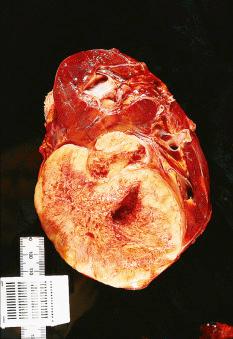
The initial analysis of 146 cases of primary malignant “neuroepithelial” tumors of the kidney from the NWTS Pathology Center files and a subsequent review of additional cases led the authors to the frustrating conclusion that these represent a diverse group of high-grade tumors which are not always easy to place in a specific category, even after their evaluation with immunohistochemical and molecular genetic tools. We would recommend keeping the diagnosis of Ewing sarcoma pure by requiring molecular confirmation. In our opinion, unusual tumors that do not fit into the Ewing sarcoma family, and for which other specific diagnostic categories are excluded (e.g. Wilms tumor), are best reported descriptively under terms such as “malignant neoplasm with neuroectodermal (or neuroepithelial) differentiation.”
Rarely, other undifferentiated round cell sarcomas have been reported in the kidney, such as those associated with CIC-DUX4 fusion.
Synovial sarcoma , which is histologically and genetically identical to its soft tissue counterpart, may rarely occur in the kidney. It is important to note that there are variable reports of PAX-8 expression in synovial sarcoma, some reporting reactivity in the spindle cells and some in glands (which may simply represent entrapped renal tubules).
Become a Clinical Tree membership for Full access and enjoy Unlimited articles
If you are a member. Log in here